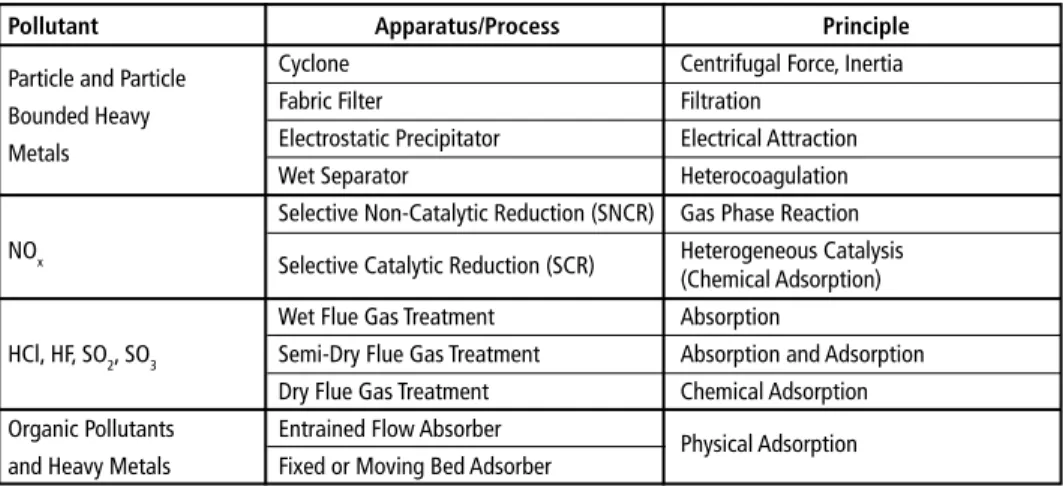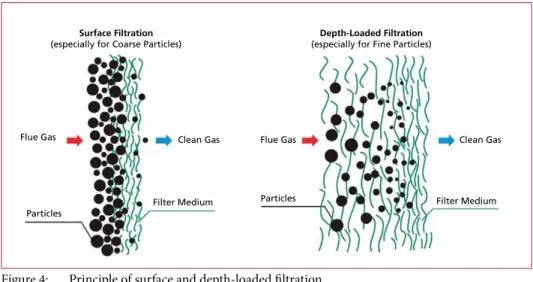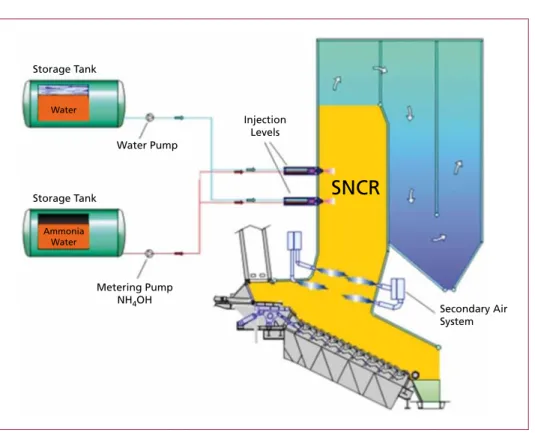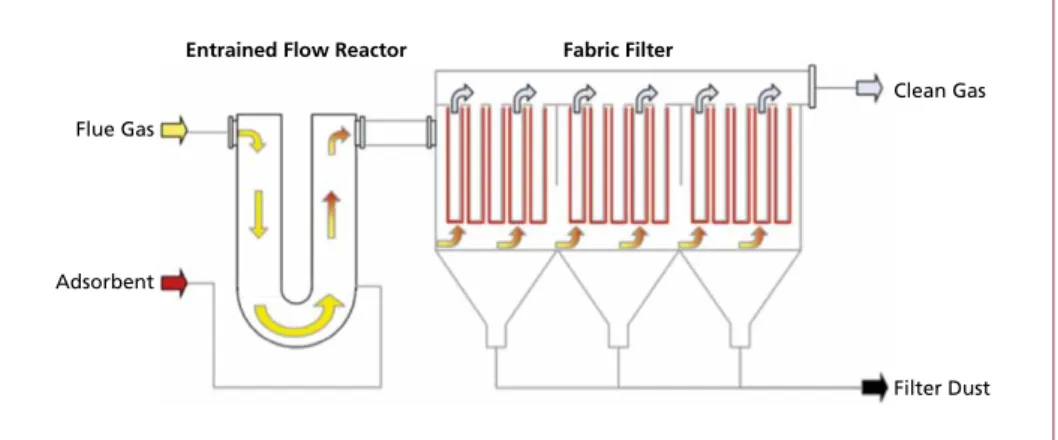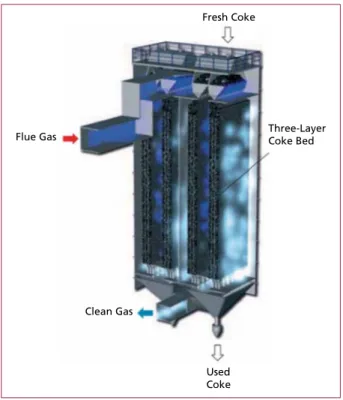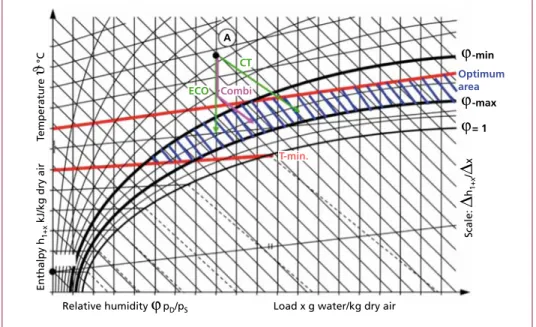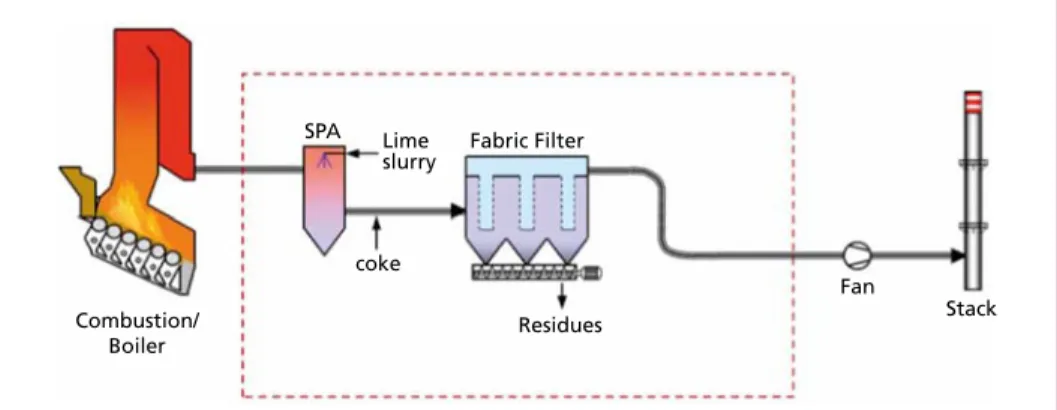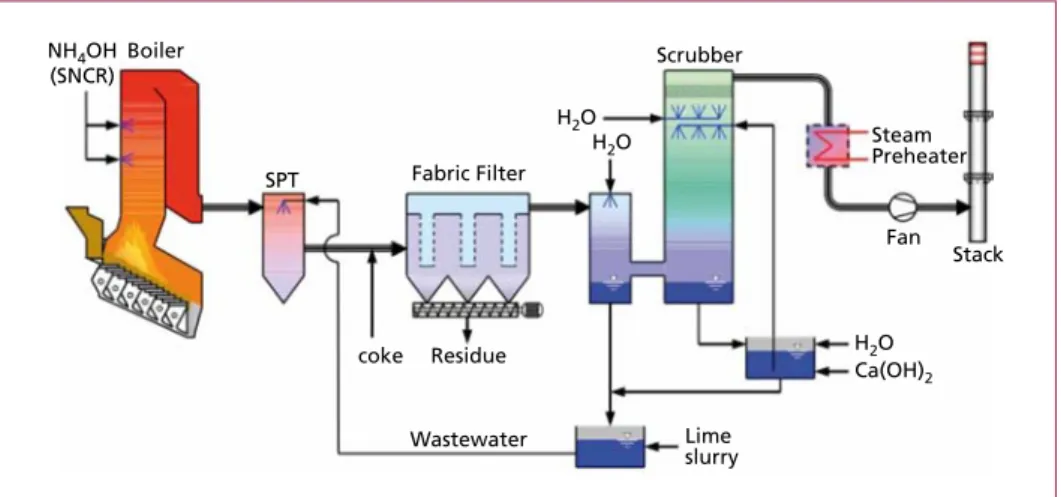193 Flue Gas Treatment – State of the Art
Waste Incineration
Flue Gas Treatment – State of the Art
Margit Löschau and Rudi Karpf
1. Flue gas treatment options ...194
1.1. Removal of particles and particle-bounded heavy metals ...194
1.1.1. Electrostatic separators ...195
1.1.2. Filtering separators ...196
1.2. Removal of NOx ...198
1.2.1. SNCR ...201
1.2.2. SCR...201
1.3. Removal of organic pollutants and vaporous heavy metals ...203
1.3.1. Entrained flow-filter layer process ...203
1.3.2. Fixed or moving bed adsorber ...203
1.4. Removal of acid compounds ...204
1.4.1. Lime-based processes ...205
1.4.2. Sodium-based processes ...211
2. Achievable emission values ...213
2.1. Particles ...213
2.2. Nitrogen oxides ...214
2.3. Acid pollutants ...215
2.4. Dust and heavy metals ...215
2.5. Overview for Germany ...215
3. Examples for concepts for retrofit and new installations ...216
3.1. Changing from a wet to a dry system ...216
3.2. Retrofit to an energy optimised concept ...217
3.3. Change from spray absorption to conditioned-dry sorption ...218
3.4. Concept for a new installation ...219
4. References ...219 For the removal of air pollutants from the flue gas, a flue gas treatment system is re- quired downstream the boiler. Such treatment systems consist of a system of cleaning processes for the reduction of particulate, vapour and gaseous substances in the flue gas.
Margit Löschau, Rudi Karpf
194
Waste Incineration
There are special flue gas treatment components for removal of special pollutants, however, some components are able to remove more than one pollutant.
The selection of the appropriate flue gas treatment system depends in particular on the composition respectively pollution of the fuel, the resulting composition of the raw gas, the expected maximum concentrations of pollutants in the raw gas and their fluctuations and the required efficiency of the treatment process to meet the applicable emission limits. An overview of the flue gas treatment components for the removal of pollutants is shown in Table 1.
Table 1: Overview of flue gas treatment components for removal of pollutants
Pollutant Apparatus/Process Principle
Particle and Particle Cyclone Centrifugal Force, Inertia
Bounded Heavy Fabric Filter Filtration
Metals Electrostatic Precipitator Electrical Attraction
Wet Separator Heterocoagulation
Selective Non-Catalytic Reduction (SNCR) Gas Phase Reaction NOx Selective Catalytic Reduction (SCR) Heterogeneous Catalysis
(Chemical Adsorption)
Wet Flue Gas Treatment Absorption
HCl, HF, SO2, SO3 Semi-Dry Flue Gas Treatment Absorption and Adsorption Dry Flue Gas Treatment Chemical Adsorption Organic Pollutants Entrained Flow Absorber Physical Adsorption and Heavy Metals Fixed or Moving Bed Adsorber
1. Flue gas treatment options
1.1. Removal of particles and particle-bounded heavy metals
For removal of particles, the following components were usually used in flue gas treat- ment systems downstream the waste incineration:
• Centrifugal Separator
• Electrostatic Separator
• Filtering Separator
• Wet Separator.
Due to their low separation efficiency, cyclones can only be used for pre-dedustig. Wet scrubbers intend to remove acidic compounds of the flue gas, the separation of dust is just a side effect (exception: venture scrubbers which are appropriate for fine dust separation). Electrostatic separators are often used in flue gas cleaning installations, mostly as pre-dedusting step upstream of a scrubber system. However, to achieve the emission limits of the European Industrial Emission Directive, fibrous layer filter with pulse jet cleaning are the most common installation for dust removal in flue gas cleaning.
195 Flue Gas Treatment – State of the Art
Waste Incineration
1.1.1. Electrostatic separators Electrostatic Separators are used to capture particulate pollutants by means of the electrostatic attraction. There are:
• Dry Electrostatic Precipitators, and
• Wet Electrostatic Precipitators.
Figure 1: Flue gas treatment systems for the removal of particles
Figure 2: Example for a typical dry electrostatic precipitator
Source: BETH Filter GmbH: Dry Electrostatic Precipitator. Company Brochure, 2014 Centrifugal
Separator
Electrostatic Separator
Filtering Separator
Wet Separator
Cyclone Multicyclone
Dry Electrostatic Precipitator
Wet Electrostatic Precipitator
Pulse-Jet Filter
Depth Loading
Filter
Depth Loading
Filter Fibrous
Layer Filter
Packed Bed Filter
Scrubbers (especially Ven-
turi Scrubbers)
High-voltage unit Support insulator with ring-type heater Suspension of the electric discharge system with rapping drives Gas distribution Discharge electrodes Collecting electrode plates
Gas inlet
Dust collecting hopper with heating
Dust conveyor system (heated)
Gas outlet
Margit Löschau, Rudi Karpf
196
Waste Incineration
Wet ESP are often used for cleaning gases saturated with water vapor in the flue gas purification of chemical processes. As part of the FGT of thermal waste treatment plants, they are rarely used, and only in combination with wet scrubbers to achieve a downstream removal of aerosols and particulate matter.
Dry ESP are more often part of the flue gas cleaning concept but usually not as the only dedusting aggregate for Waste-to-Energy plants as the emission limit of 10 mg/Nm3 can hardly be met. An exemplarily design of a dry ESP is shown in Figure 2.
In the ESP, the particles are electrically charged in an electric field – 20 and 100 kV – and disposed at the collecting electrode. The principle is shown in Figure 3.
Profiled collection
plates Emission electrode Flow shadow Collection pockets
Figure 3: Removal of dust in an electrostatic precipitator
Source: Scheuch GmbH: Dry Electrostatic Precipitator. Company Brochure
1.1.2. Filtering separators
Filtration is a mechanical process for separating mixture of substances. Both mixtures of liquid and solids – suspensions – and mixtures of gases and solids can be separated.
For filtering, the mixture pass through a filter medium. Through the filter medium e.g.
particles will be retained from the gas stream.
Surface Filtration
(especially for Coarse Particles) Depth-Loaded Filtration (especially for Fine Particles)
Flue Gas
Particles
Clean Gas
Filter Medium
Flue Gas
Particles
Clean Gas
Filter Medium
Figure 4: Principle of surface and depth-loaded filtration
Source: Liqui-Filter, company material. Im Internet: http://www.liqui-filter.info/know-how/absaugen-und-filtern-von-luft/wie- arbeiten-unsere-filter.html, extracted on 1st February 2012, edited
197 Flue Gas Treatment – State of the Art
Waste Incineration
The filter effect depends on the particle size and can take place on the surface of the filter medium, but also in the filter medium itself. Accordingly, there are:
• Surface Filtration, and
• Depth-Loaded Filtration (Figure 4).
With respect to the filter medium one distinguishes between:
• Fibrous Layer Filter, and
• Packed Bed Filter.
For dust removal in the flue gas of Waste-to-Energy plants, only fibrous layer filters which can be cleaned on-line (during operation) can be used. Fabric filters with 4 to 8 chambers (mostly 6), vertical bags and pulse jet for cleaning the filter tubes are com- monly installed in waste incineration plants (Figure 5). Filter designs with horizontal bags also exists.
If the fabric filter operates not only as a dust collector but also as a sorption filter the filter medium should be always designed for a surface filtration.
Figure 5:
Typical design of a fabric filter with chambers and vertical tubes
Source: Scheuch GmbH: Bauformen Filter / Abscheider. In the Internet: http://
www.scheuch.com/de/filter_abschei- der_impulsfilter_bauformen/, extracted April 2013
Margit Löschau, Rudi Karpf
198
Waste Incineration
1.2. Removal of NO
xFor the removal of NOx two established processes exist:
• Selective Non-Catalytic Reduction (SNCR), and
• Selective Catalytic Reduction (SCR).
Both processes are able to remove NOx with the efficiency needed to meet an emission value of 100 mg/m3 STP. Reagents and plant configurations are shown in Figure 6.
SNCR
With Ammonia
Water (NH4OH) With Urea
SCR
High-Dust Low-Dust Tail-End
Figure 6: Flue gas treatment systems for the removal of NOx
Figure 7: Example for a SNCR system
Source: Martin GmbH für Umwelt- und Energietechnik: Firmenbroschüre Das Martin SNCR System Storage Tank
Storage Tank Water
Water Pump
Injection Levels
SNCR
Metering Pump NH4OH
Secondary Air System Ammonia
Water
201 Flue Gas Treatment – State of the Art
Waste Incineration
1.2.1. SNCR In the selective non-catalytic reduction process (SNCR) nitrogen oxide (NOx) in the flue gas is reduced by reaction with ammonia (NH3) to elemental nitrogen (N2). For this purpose, aqueous ammonia solution (NH4OH) or urea solution (NH2CONH2) is injected into the hot flue gas in the first boiler pass. As a carrier medium for the re- agent, pressurised air, steam or pressurised water can be used. A typical SNCR system is shown in Figure 7.
NH4OH → NH3 + H2O
4 NO + 4 NH3 + O2 → 4 N2 + 6 H2O 2 NO2 + 4 NH3 + O2 → 3 N2 + 6 H2O
To avoid NH3-slip, NH3 oxidation and NO generation, the reduction reaction in the SNCR process takes place in a narrow temperature range from 850 to 1.100 °C, with an optimum at approximately 970 °C (Figure 8). For the optimisation of the injections of reagent in the right temperature zone an IR-pyrometer or an acoustical gas temperature measurement can be installed. The efficiency of SNCR can be increased by increasing the stoichiometric factor for ammonia water but is limited due to the inevitable NH3-slip.
Figure 8:
NH3-reaction depending on temperature as a function of temperature
Source: Dittrich, R.; Nowag, R.: Ver- gleichende Beurteilung und Abscheide- leistung von SNCR-/SCR-Technik. VDI- Wissensforum: BAT und preisorientierte Rauchgasreinigungstechniken, München, 2002, edited
1.2.2. SCR In the selective catalytic reduction process (SCR), a catalyst is used to increase the efficiency of the reaction of nitrogen oxide (NOx) in the flue gas with the reagent ammonia (NH3).
100
80
60
40
20
0
650 750 850 950 1.050 1.150 1.250
NH3 oxidation NO reduction NO generation NH3 slip
NH3-Reaction
%
Temperature
°C
Margit Löschau, Rudi Karpf
202
Waste Incineration
NH3 is mostly provided by the injection of ammonia water. The reaction equations are the same as for the SNCR but the catalysed process takes place at lower temperatures (160 to 450 °C). As ammonia water is converted almost stoichiometrically there is hardly any NH3-slip. With respect to the location of the SCR-catalyst there are four different plant configurations (Figure 9):
a) High-Dust-SCR
b) Low-Dust/High SOx-SCR c) Low-Dust/Low-SOx-SCR d) Tail-End-SCR.
Boiler Fabric Filter
or ESP
Fabric Filter Stack
a b c d
Scrubber
Figure 9: Plant configurations for SCR
Source: Karpf, R.: Überblick zur Abgasreinigung. 10. Fachtagung Abgasreinigung von Feuerungsanlagen und thermische Prozesse; Haus der Technik, Essen, 25-26th June 2015
Most common for Waste-to-Energy installations is the Tail-End-SCR (Figure 10) which is located downstream the removal of particles and acid compounds in the flue gas and therefore ensures long lifetime of the catalyst. However, as the temperature of the flue gas after the fabric filter is usually too low for the catalytic reduction of NOx, for this configuration a reheating of the flue gas is necessary, which requires steam or natural gas. Most common are catalysts consisting of TiO2 as carrier material with V2O5 as active component and WO3 as promoter.
Ammonia Water
SCR
ID Fan Stack
Saturated HP-Steam Condensate Clean Gas
Flue Gas from Fabric Filter
Figure 10:
Typical Tail-End-SCR-Concept
203 Flue Gas Treatment – State of the Art
Waste Incineration
1.3. Removal of organic pollutants and vaporous heavy metals
For the removal of organic pollutants (mainly PCDD/F) and vapour forms of heavy metals (mainly Hg), the following established processes exist:
• Entrained Flow-Filter Layer Process
• Fixed or Moving Bed Adsorber.
For organic pollutants, additionally an oxidation catalyst can be used.
1.3.1. Entrained flow-filter layer process In an entrained flow adsorber, the adsorbent (mostly lignite active coke) is injected directly into the flue gas and carried away with this. Organic pollutants (such as PCDD/F) and heavy metals in vapour form (such as Hg) are adsorbed on the surface of the adsorbent and removed with the particles in the downstream fabric filter. On the filter bags of the fabric filter layer of dust and adsorbent is developed which contributes to the adsorption processes. In Figure 11 the basic principle of the entrained flow-filter layer process is shown.
Flue Gas
Entrained Flow Reactor Fabric Filter
Adsorbent
Clean Gas
Filter Dust
The advantage of this process is that it can be perfectly combined with conditioned-dry removal of acid compounds where usually a reactor and a fabric filter are part of the system too. So the technical equipment can be minimised.
1.3.2. Fixed or moving bed adsorber Fixed or moving bed adsorbers are usually located downstream of a wet FGT process (Figure 12). The flue gas flows through a granular bed of an adsorbent. For technical and economic reasons, mostly lignite coke is chosen. The separation of organic pollutants and vaporous heavy metals is based on the principle of physical adsorption.
Figure 11: Principle of an entrained flow-filter layer process
Margit Löschau, Rudi Karpf
204
Waste Incineration
1.4. Removal of acid compounds
For the removal of acid compounds, mainly HCl and SO2 downstream waste incine- ration, there are the following three established flue gas treatment systems in Europe:
• wet
• semi-dry and
• dry.
Usually, calcium or sodium based absorbent are used as reagent for the removal. In Figure 13, the further subdivision of the main systems is shown.
Fresh Coke
Used Coke
Three-Layer Coke Bed
Clean Gas Flue Gas
Figure 12:
Example for a moving bed adsorber with four three-layer active coke bed
Source: Thermische Abfallbehandlung Lauta GmbH & Co. oHG: Aufbau und Funktion: Aktivkoksfilter. In the Internet:
http://www.t-a-lauta.de/aufbau-funktion/
aktivkoksfilter.html, extracted 23rd Janu- ary 2012, edited
Dry Flue Gas Treatment
Direct Desul- phurisation with Ca(OH)2
or CaCO3
Dry Sorption NaHCOwith3
Dry Sorption Ca(OH)with2
Conditioned- Dry with Ca(OH)2
Spray Absorption Lime Slurrywith
Acid Scrubbing with H2O Moisturing of
Reagent in the Humidification
Mixer
Moisturing of Flue Gas in the Evaporation
Cooler
Moisturing of Reagent and Flue Gas in the Reactor
in Combination with Neutral
Scrubbing with NaOH
in Combination with Neutral
Scrubbing with Ca(OH)2
in Combination with Neutral
Scrubbing with CaCO3 Semi-Dry
Flue Gas Treatment
Flue GasWet Treatment
Figure 13: Flue gas treatment systems for the removal of acid compounds
205 Flue Gas Treatment – State of the Art
Waste Incineration
1.4.1. Lime-based processes The separation of the pollutants takes place via adsorption on the surface of calcium hydroxide particles. These particles are brought into contact with the flue gas in a variety of forms. The primary reactions take place according to the following equations:
SO2 + Ca(OH)2 → CaSO3 x ½ H2O + ½ H2O SO3 + Ca(OH)2 → CaSO4 + H2O
2 HF + Ca(OH)2 → CaF2 + 2 H2O CO2 + Ca(OH)2 → CaCO3 + H2O 2 HCl + Ca(OH)2 → CaCl2 x 2 H2O Reaction of lime with HCl in two steps:
Ca(OH)2 + HCl → Ca(OH)Cl + H2O (l) Ca(OH)Cl + HCl CaCl2 + H2O (l) Reaction of lime with calcium chloride:
Ca(OH)2 + CaCl2 2 Ca(OH)Cl
The reactivity sequence between calcium hydroxide and the pollutants can be set out as follows:
SO3 > HF > HCl >> SO2 > CO2
The most important calcium-hydroxide-based processes are described in below.
1.4.1.1. Conditioned-dry sorption with hydrated lime In this process, separation of the pollutants via deposition on lime is ameliorated by a hydrate shell which is formed around – and inside the pores of – the lime particles and results from the H2O contained in the flue gas. This means that the separation is governed by the dissolution rate of the pollutants in aqueous solution. The absorption and adsorption processes run parallel throughout the separation process.
An increased level of relative humidity is required for the capillary condensation and the formation of the hydrate shell on the surface. The flue gas is therefore first conditioned in order to optimize the downstream pollutant separation process. This conditioning consists primarily of a reduction of the gas temperature to approximately 130 to 150 °C in order to achieve a relative humidity of approximately 6 percent. Flue gas temperatures below 130 °C should, however, be avoided, as, depending on surface temperature, the salts created during the reaction may increase the risk of corrosion to those parts of the facility in direct contact with the flue gas.
The presence of liquid water allows for the dissolution of the reaction partner (see the following reactions) and for an ionic reaction to take place, the fastest reaction rate at our disposal.
Margit Löschau, Rudi Karpf
206
Waste Incineration
Ca(OH)2
� � ®
H2�
O Ca(OH)2(aq) Ca2+(aq) + 2 OH-(aq)
SO2 + 3 H2O H3O+(aq) + HSO3-(aq) + H2O 2 H3O+(aq) + SO32-(aq) HCl + H2O H3O+(aq) + Cl-(aq)
HF + H2O H3O+(aq) + F-(aq) Ca2+(aq) + SO32-(aq) → CaSO3(aq) Ca2+(aq) + 2 Cl-(aq) CaCl2(aq) Ca2+(aq) + 2 F-(aq) → CaF2(aq) H3O+(aq) + OH-(aq) → 2 H2O
Reducing the temperature or increasing the relative humidity can be effected via an economizer (ECO) or a cooling tower (CT). However, a combination (Combi) of both the gas cooling and humidifying processes is also possible. The cooling tower allows one to increase the absolute humidity in the system via the amount of injected water. The injected water promotes the separation of pollutants adhering to the hydrate lime particles.
A
CT ECO Combi
Optimum area
-min
T-min.
ϕ
ϕ-max
= 1
Scale:
∆
h1+x/∆
xRelative humidity ϕ pD/pS Load x g water/kg dry air Enthalpy h1+x kJ/kg dry airTemperature ϑ °C
ϕ
Figure 14: Mollier h-x diagram with optimum temperature-humidity range for conditioned dry absorption with calcium hydroxide (A = starting point)
Source: Karpf, R.; Basic features of the dry absorption process for flue gas treatment systems in waste incineration; Earth Engineering Center, Columbia University, New York, April 2015
In order to increase the separation efficiency, a part of the residue of the reaction products in the fabric filter should be feed back into the flue gas. This permits the un-reacted contingent to be brought back into contact with the pollutants as well as
207 Flue Gas Treatment – State of the Art
Waste Incineration
providing a quantity of chloride to improve separation efficiency, especially that of SO2. Concerning the presence of calcium chloride, a quantity of HCl/SO2 > 1 at the inlet of the flue gas treatment system is necessary.
Figure 15: Conditioned dry process with hydrated lime
Cooling Tower
Ca(OH)2 + coke
Residues Recirculation
Fabric Filter
Combustion/
Boiler
Fan Stack
H2O
The higher the fabric filter temperature, the less efficient the SO2-separation due to the decrease in relative humidity.
1.4.1.2. Spray absorption with lime slurry The semi-dry spray absorption process is an alternative method. Here a spray dryer is used to inject a suspension of lime and water (lime slurry) into the flue gas stream.
The suspension is generally created from quicklime (CaO) and water via an on-site slaking process. The fact that this is conducted on-site is of additional benefit to the reactivity of the reagent. When the suspension is injected into the flue gas stream, the water component evaporates and only the solid lime particles remain in the flue gas. The liquid phase of this process has proven to be more efficient concerning HCl-removal than it is by applying slaked lime (calcium hydroxide) in dry form.
coke
Residues SPA Lime
slurry Fabric Filter
Combustion/
Boiler
Fan Stack
Figure 16: Spray absorption process with lime slurry (SPA = Spray Absorber)
Margit Löschau, Rudi Karpf
208
Waste Incineration
Since CO2 is also an acid gas component, the amount of CO2-molecules compared to the amount of the other acid gas molecules such as HCl, HF, SO2 is much higher.
Consequently, the possibility of a reaction between CO2 and a lime particle is much greater than that of a reaction between the other acid gas components and formed calcium carbonate (CaCO3). For the liquid phase, an HCl- or SO2-molecule can react with the already formed CaCO3 and out through the CO2-molecule again due to the higher acid state. However, this is only possible in the case of the liquid phase.
Therefore, the spray absorption process will operate with a higher lime consumption (higher stoichiometric ratio (SR)) compared to a conditioned dry absorption process with a dry lime injection. The dosage of lime slurry that is applied is generally too high in cases of a stoichiometric ratio of 2.3 < SR < 3.5. In order for sufficient drying of the particles, an inlet temperature of approximately 200 °C and a certain outlet tempera- ture (mostly > 140 °C) prior to the spray absorber process is desirable, depending on the dimensions of the spray absorber (e.g. residence time). In some cases, the outlet temperature should be lower than 140 °C, especially for SO2-removal, except where this is not possible. If a higher degree of separation efficiency is required, dry calcium hydroxide can be injected upstream of the fabric filter.
1.4.1.3. Lime slurry scrubber
In a wet flue gas treatment system the acid compounds of the raw gas are absorbed in a liquid in a scrubbing system. While semi-dry and dry flue gas treatment systems are always waste water free, in wet flue gas treatment systems the waste water from the scrubbers which is contaminated with salts and heavy metals has to be taken account to. This waste water must be treated in an appropriate manner, using either
• waste water cleaning or
• an effluent evaporation.
Both variants cause high technical effort and herewith high investment cost. Because even after a cleaning process the discharge of saline effluent is in most countries critical, a wet flue gas system should be designed effluent-free which requires a spray dryer and a fabric filter upstream the scrubbing system. Most common for waste incineration plants are wet systems with water as absorbent for HCl and with lime milk as absorbent for SO2 (Figure 17).
Beside hydrated lime, sodium hydroxide or limestone solution as absorbent are pos- sible to be used.
The typical wet system for waste incineration consists of two scrubbers, one for the removal of HCl in an acid environment and one for the removal of SO2 in a neutral environment. The acid liquids are neutralised with hydrated lime.
HCl(g) + H2O(l) → H3O+ + Cl– SO2(g) + H2O(l) H+ + HSO3– 2 HSO3– + Ca2+ → Ca(HSO3)2
Ca(HSO3)2 + Ca(OH)2 + O2 + 2 H2O → 2 CaSO4 · 2 H2O
211 Flue Gas Treatment – State of the Art
Waste Incineration
For the evaporation of the salt solution a spray dryer must be installed. The vaporised salts are removed in the downstream fabric filter. The higher the raw gas concentration, the higher is the amount of water which has to be evaporated in the spry dryer. De- pending on raw gas concentration, relatively high raw gas temperatures after the boiler are required which can be adverse to energy efficiency of the boiler. Lignite activated coke can be used in addition to eliminate lightly volatile heavy metals (e.g. mercury) and hazardous organic pollutants (e.g. PCDD/F).
1.4.2. Sodium-based processes 1.4.2.1. Dry sorption with sodium hydrogen carbonate Sodium hydrogen carbonate allows the implementation of a purely dry technique, as it enables a good dedusting result for HCl und SO2 at comparatively high temperatures and regardless of the flue gas humidity.
As, in most cases, activated carbon is added to the sodium bicarbonate during the process in order to achieve a better dedusting result with regard to heavy metals and dioxins/furans in the flue gas, the flue gas temperature must be cooled to 140 to 180 °C in order to prevent desorption occurring in the activated carbon. At temperatures
> 140 °C, the sodium hydrogen carbonate decomposes into sodium carbonate (NaCO3), carbon dioxide (CO2) and water (H2O):
2 NaHCO3
�
s�
>140� �
°C®
Na2CO3 + CO2 + H2O Na2CO3 + SO2 → Na2SO3 + CO2 Na2SO3 + ½ O2 → Na2SO4Na2CO3 + 2 HCl → 2 NaCl + CO2 + H2O
Na2CO3 + 2 HF → 2 NaF + CO2 + H2O
coke Residue H2O
H2O H2O
Ca(OH)2
Wastewater SPT
Limeslurry Fabric Filter
Boiler NH4OH (SNCR)
Fan Steam Preheater Scrubber
Stack
Figure 17: Wet flue gas cleaning system with lime slurry and spray absorber
σ > 140 °C
Margit Löschau, Rudi Karpf
212
Waste Incineration
The reactivity sequence can be set out as follows:
SO3 > HCl > SO2 >> HF > CO2
When compared to the application of lime, the chemical decomposition and transition of the gaseous reaction products into the flue gas stream reduces the quantity of residue requiring subsequent disposal.
This decomposition also leads to a greater specific surface. The greater the available reaction surface, the more efficient the separation performance of the sodium carbonate.
The removal performance also generally increases in line with a rise in temperature.
The temperature must, however, be confined to a specific corridor if activated carbon is also being used to separate mercury.
Figure 18: Dry FGT process with sodium hydrogen carbonate Main Features of the process:
• Very good reactivity of NaHCO3 with HCl and SO2
• The higher the temperature, the more efficient the separation of HCl and SO2. However, limitation of the temperature is advisable due to mercury separation
• The desired temperature corridor should lie between 180 to 190 °C if activated carbon is being used
• Desired bicarbonate grind: the smaller the grain size, the better the separation performance
• No influence of HCl/SO2 ratio on separation performance
• No influence of humidity on separation performance
• Poor reactivity with HF
• Stoichiometric values of 1.1 < SR < 1.4 are common. A slight improvement in the separation performance if recirculation is applied within the bicarbonate process
• Additives are very expensive
• Low amount of residual substances compared to lime-based process.
Economiser t < 180°C
NaHCO3 +coke
Residues Bag Filter
Combustion/
Boiler
Fan Stack
213 Flue Gas Treatment – State of the Art
Waste Incineration
1.4.2.2. Sodium hydroxide scrubber Sodium-based reagents in form of sodium hydroxide are also used in wet flue gas cleaning systems to remove the acids from the flue gas:
NaOH(l) + H2O(l) → Na+ + OH– + H2O(l) HSO3– + Na+ → NaHSO3(l)
SO42– + 2 Na+ → Na2SO4(l)
A typical plant configuration is shown in Figure 19.
Lime Slurry
coke Residue H2O
H2O H2O
NaOH Wastewater
SPT Fabric Filter Boiler
NH4OH (SNCR)
Steam Preheater Scrubber
Fan Stack
2. Achievable emission values 2.1. Particles
The fractional efficiency of the different de-dusting technologies varies greatly (Figure 20).
Cyclones are only appropriate for pre-dedusting to remove coarse particles xp >10 µm.
E.g. a cyclone which is able to separate particles with a size of 10 µm with an efficiency of approximately 80 percent (depending on the cyclone diameter) will separate particles with 5 µm only with an efficiency of 5 percent.
Electrostatic precipitators (ESP) as single dedusting aggregate do not reach the ef- ficiency to be in accordance with the dust emission limit of 10 mg/m3 STP for waste incineration. The main task of a scrubber is not to remove particles but to remove acid pollutants, even though particles will be separated in the scrubber. Venturi scrubbers are implemented to reduce fine particles and aerosols but are not able to handle the whole fly ash amount. Therefore it is most common to install another de-dusting technology upstream the scrubbers to reduce the dust load of inlet flues gas.
Only fabric filters are suitable for removal of particle sizes xp < 10 µm with a sufficient efficiency needed to reach the emission limit of 10 mg/m3 STP.
Figure 19: Wet FGT process with sodium hydroxide
Margit Löschau, Rudi Karpf
214
Waste Incineration
2.2. Nitrogen oxides
SNCR as well as SCR are state-of-the art technologies to comply with the emission limits for Waste-to-Energy plants. In Figure 21 an evaluation of the NOx emissions
Figure 20:
Fractional efficiency of different de-dusting technologies
Source: Müller, C.; Stark, R.: Trends in der Abgasreinigung zur Beherrschung des Quecksilber- und Feinstaubproblems – Technische Lösungen. In: Thomé- Kozmiensky, K. J.; Beckmann, M. (Hrsg.):
Energie aus Abfall, Band 2. Neuruppin:
TK Verlag Karl Thomé-Kozmiensky, 2007, edited
Figure 21: Emissions of NOx of municipal solid waste incineration plants in Germany considering flue gas treatment system SNCR and SCR (number of plants = 50)
215 Flue Gas Treatment – State of the Art
Waste Incineration
of 50 Waste-to-Energy plants in Germany considering the DeNOx system is shown.
Basically, with the SCR lower emission values for NOx are possible.
2.3. Acid pollutants
The dry flue gas treatment system with sodium hydrogen carbonate is flexible if varia- tions of the raw gas concentration of acid compounds occur. The stoichiometric ratio varies between 1.1 to 1.3, even if there are very high concentrations of HCl und SO2. It is possible to go approximately 50 percent below the limits of the European Directive on Industrial Emissions with just slightly increased amount of NaHCO3.
The semi-/conditioned dry flue gas treatment systems have to operate with a higher stoichiometric ratio (approximately 2) to be able to buffer away raw gas peaks and ensure the compliance of the limits. In wet and effluent-free flue gas treatment systems the gas temperature difference between boiler exit and fabric filter defines the amount of vaporisable salt solution. Therefore, the wet flue gas treatment has to operate with higher raw gas temperatures in case of high raw gas concentrations of HCl and SO2 (much higher than at present design point). The scrubbers are designed for a fixed ef- ficiency (height of scrubber, number of levels with nozzles). Almost zero emissions of HCl are possible. Absorbent consumption is stoichiometric and therefore most efficient.
2.4. Dust and heavy metals
For dry and semi-dry flue gas cleaning systems, the removal of heavy metals depends on dust removal efficiency because most heavy metals are condensed at the surface of dust particles. Therefore, the efficiency of removal of particle bounded heavy metals such as Cd, Tl, Sb, As, Pb, Cr, Co, Cu, Mn, Ni, V und Sn cannot be higher than the efficiency of dust removal. Removal of mercury as a vaporous heavy metal can be controlled by the application of activated carbon. Please keep in mind that the adsorption efficiency is a function of the adsorption temperature!
For effluent free wet flue gas treatment systems, the efficiency of fine dust removal and herewith the particle bounded heavy metals is determined also by the efficiency of the fabric filter. An additional removal can be reached by the use of a venturi step, which, however, causes an additional pressure loss and therefore higher electricity consump- tion. However, the wet system allows higher separation of mercury present as chloride which is soluble in the scrubber water.
2.5. Overview for Germany
In Figure 22, the annual average emissions of municipal solid waste incineration plants in Germany are shown. In average operation, all emissions are much below the legal standard, for dust, heavy metals and dioxins actually below 10 percent of the limit. There are no appreciable differences in the efficiency of wet and semi-dry/conditioned-dry flue gas cleaning concepts except for HCl, where wet flue gas treatment reaches very low emission values.
Margit Löschau, Rudi Karpf
216
Waste Incineration
Figure 22: Emissions of municipal solid waste incineration plants in Germany for different flue gas treatment systems (number of plants = 50)
For further details please refer to Löschau [11].
3. Examples for concepts for retrofit and new installations
The following examples give an impression about the potential of optimisation and ideas/concepts for new installations.
3.1. Changing from a wet to a dry system
Many wet flue gas treatment systems of waste incineration plants are at the end of their lifetime, which makes a retrofit necessary. However, more and more frequently plant
100 90
70 80
40 50 60
30 20 10
%
Emission limits acc. to 17. BImSchV (German IED equivalent) Annual average emission of MSWI plants with semi-dry or conditioned-dry flue gas cleaning
Annual average emission of MSWI plants with wet flue gas cleaning
B(a)P+
As+Cd+
Co+Cr PCDD/F
50 mg/Nm3 10
mg/Nm3 10 (5) mg/Nm3 1
mg/Nm3 50
mg/Nm3 200 (150) mg/Nm3 10
mg/Nm3 0,03 mg/Nm3 0,05
mg/Nm3 0,5 mg/Nm3 0,05
mg/Nm3 0,1 mg/Nm3
TOC
CO HCl HF SO2 NOx Dust Hg Cd+TI Sb+As+
Pb+Cr+
Co+Cu+
Mn+Ni +V+Sn 0
Figure 23: Formerly flow sheet of the wet system
Coke Spray dryer
Fabric Filter
Residues Lime Slurry
Neutralization Gypsum
Heat exchanger Ammonia SCR
Induct burner SO2-
scrubber HCl-
scrubber
Fan
Stack
217 Flue Gas Treatment – State of the Art
Waste Incineration
operators decide to substitute the wet system (an example is shown in Figure 23) by a dry (an example is shown in Figure 24) or conditioned-dry system. The following changing from a wet to a dry system is based on an optimisation of the operating costs with the same emission limits.
NH4OH Induct burner
SCR t = 180°C
Residue Fabric Filter Boiler
NaHCO3
coke
water Cooling Tower
Fan Stack
The change results in savings by:
• loss of natural gas consumption by the loss reheating in the SCR-system
• loss of the gas-gas-heat exchanger instead
• using the enthalpies of the flue gas for the preheat of the turbine condensate by a heat exchanger upstream of the stack
• reduction of the electrical energy consumption because of loss scrubber operation (reduction of pressure loss, loss of the pumps, loss of the gas-gas-heat exchanger).
In Table 2 the main results from the concept evaluation are summarised.
Figure 24: Afterwards flow sheet of installed dry system
Parameter Saving in MWh Saving in %
Electrical energy consumption 15.000 48
Natural gas consumption 54.000 97
Steam consumption/heat recovery 31.000 84
Table 2:
Results from the concept eva- luation
For further details of the concept please refer to Karpf [8].
3.2. Retrofit to an energy optimised concept
In the recent years, energetic optimisation of Waste-to-Energy plants is focused more.
The main goal for the following optimisation (Figure 25) is the realisation of an energy recovery nearly with the existing equipment.
The advantages of this concept are as follows:
• Separation of the main pollutant HCl with the cheap CaO (lime slurry)
Margit Löschau, Rudi Karpf
218
Waste Incineration
• Keep the requested emission levels of HCl, SO2 with sodium bicarbonate (NaHCO3) also with various waste compositions
• Operate the existing catalysts as a low temperature catalyst at ~ 180 °C
• Loss natural gas (unless for start-up or thermal regeneration)
• Loss of the gas/gas-heat exchanger (~ 20 mbar)
• Heat recovery (~ 1 MWh/line with 50 K temperature reduction for the calculated system, but depends on the size of the plant)
• Reduction of corrosion problems.
ϑ
= 230 °Cϑ
= 180 °CLime slurry NaHCO3/HOK H2O Ca(OH)2
ϑ ∼
130 °CΔϑ ∼
50 KFigure 25: Flow sheet from an energy optimised dry absorption system
3.3. Change from spray absorption to conditioned-dry sorption
Also the replacement of a spray absorption system by a conditioned-dry system could have significant advantages and can reduce the plant`s operation costs (Table 3). Fur- thermore the cooling effect can be increased with the pure water injection instead of lime milk injection so that the SO2-reduction can be significantly increased too.
Operation Costs Unit Conditioned Spray dry absorption absorption
Lignite coke EUR/h 3,048 3,048
Activated coke EUR/h 0 0
Lime Ca(OH)2 EUR/h 21,15 26,741
Lime CaO EUR/h – 10,71
Water EUR/h 2,49 2,21
Compressed air (8 bar) EUR/h 54,4 54,4
Electrical energy EUR/h 16,24 18,56
Residual products EUR/h 61,56 73,32
Sum operation costs EUR/h 158,89 188,99
Difference EUR/h 0 30,11
Difference % 0 18,95
Annual costs at 8.000 h/a EUR/a 1.271.084 1.511.928
Difference EUR/a – 240.844
Table 3:
Exemplarily comparison of operation costs for substitu- tion of spray absorption by conditioned-dry system with cooling tower
219 Flue Gas Treatment – State of the Art
Waste Incineration
For further details please refer to Karpf und Pohl [9].
3.4. Concept for a new installation
In the following example, a two staged dry flue gas treatment system with sodium bi- carbonate and lime in combination with a SCR was implemented as optimal solution (Figure 26). The reasons for that concept for a new installation was to realise for all pol- lutants 50 percent of EU emission limits and for NOx emission even values < 70 mg/m³.
Furthermore it was a requisition on an optimised energy efficiency and heat recovery.
Boiler
Fabric Filter
t = 240 °C Ca(OH)2
+ Coke
Fabric Filter t = 120 °C
NaHCO3 Residue NH4OH Recirculation Residue
Fan Stack Eco
H2O Mill
In Table 4 the consumptions of this concept are shown.
Figure 26: Flow sheet for a flue gas treatment combination of sodium bicarbonate and lime (Waste- to-Energy Plant Delfzijl (NL)
For further details to the concept please refer to Bieber und Karpf [2].
4. References
[1] BETH Filter GmbH: Dry Electrostatic Precipitator. Company Brochure, 2014
[2] Bieber, H.; Karpf, R.: 25. VDI-Fachkonferenz Thermische Abfallbehandlung, Würzburg 10-11th October 2013
[3] Brauer, H. (Hrsg.): Additiver Umweltschutz: Behandlung von Abluft und Abgasen. Handbuch des Umweltschutzes und der Umweltschutztechnik – Band 3. Berlin, Heidelberg: Springer Ver- lag, 1996
Electrical Energy kWh/t 20
Lime Ca(OH)2 kg/t 0.8
Sodium bicarbonate NaHCO3 kg/t 20
Active coke kg/t 0.1
Pressurised air m³/t 15
Ammonia kg/t 2.2
Residues kg/t 35
Waste water kg/t 0
Energy recovery kW/t waste 230
Table 4:
Consumptions of WtE plant Delfzijl (NL)
Margit Löschau, Rudi Karpf
220
Waste Incineration
[4] Dittrich, R.; Nowag, R.: Vergleichende Beurteilung und Abscheideleistung von SNCR-/SCR- Technik. VDI-Wissensforum: BAT und preisorientierte Rauchgasreinigungstechniken, Mün- chen, 2002
[5] Hitachi Zosen Inova: Funktionsprinzip Ringjet. Company Brochure
[6] Karpf, R.: Basic features of the dry absorption process for flue gas treatment systems in waste incineration; Earth Engineering Center, Columbia University, New York, April 2015
[7] Karpf, R.: Überblick zur Abgasreinigung. 10. Fachtagung Abgasreinigung von Feuerungsanlagen und thermische Prozesse; Haus der Technik, Essen, 25-26th June 2015
[8] Karpf, R.; Krüger, T.: Berliner Abfallwirtschafts- und Energiekonferenz, 25.-26. January 2011 [9] Karpf, R.; Pohl, M.: International VDI Workshop Challenges of flue gas treatment in the future
– intelligent concepts, 5th May 2015, Düsseldorf
[10] Liqui-Filter: company material. Im Internet: http://www.liqui-filter.info/know-how/absaugen- und-filtern-von-luft/wie-arbeiten-unsere-filter.html, extracted on 1st February 2012
[11] Löschau, M.: Reinigung von Abgasen – unter besonderer Berücksichtigung der thermischen Abfallbehandlung. Text and practical handbook, 496 pages. Neuruppin: TK Verlag Karl Thomé- Kozmiensky, 2014
[12] Martin GmbH für Umwelt- und Energietechnik: Firmenbroschüre Das Martin SNCR System [13] Müller, C. Stark, R.: Trends in der Abgasreinigung zur Beherrschung des Quecksilber- und Fein-
staubproblems – Technische Lösungen. In: Thomé-Kozmiensky, K. J.; Beckmann, M. (Hrsg.):
Energie aus Abfall, Band 2. Neuruppin: TK Verlag Karl Thomé-Kozmiensky, 2007, pp. 401-415 [14] Scheuch GmbH: Bauformen Filter/Abscheider. In the Internet: http://www.scheuch.com/de/
filter_abscheider_impulsfilter_bauformen/, extracted April 2013 [15] Scheuch GmbH: Dry Electrostatic Precipitator. Company Brochure
[16] Thermische Abfallbehandlung Lauta GmbH & Co. oHG: Aufbau und Funktion: Aktivkoksfilter.
In the Internet: http://www.t-a-lauta.de/aufbau-funktion/aktivkoksfilter.html, extracted 23rd January 2012
Vorwort
4
Bibliografische Information der Deutschen Nationalbibliothek Die Deutsche Nationalbibliothek verzeichnet diese Publikation in der Deutschen Nationalbibliografie; detaillierte bibliografische Daten sind im Internet über http://dnb.dnb.de abrufbar
Thomé-Kozmiensky, K. J.; Thiel, S. (Eds.): Waste Management, Volume 5 – Waste-to-Energy –
ISBN 978-3-944310-22-0 TK Verlag Karl Thomé-Kozmiensky
Copyright: Professor Dr.-Ing. habil. Dr. h. c. Karl J. Thomé-Kozmiensky All rights reserved
Publisher: TK Verlag Karl Thomé-Kozmiensky • Neuruppin 2015
Editorial office: Professor Dr.-Ing. habil. Dr. h. c. Karl J. Thomé-Kozmiensky, Dr.-Ing. Stephanie Thiel, M. Sc. Elisabeth Thomé-Kozmiensky.
Layout: Sandra Peters, Ginette Teske, Janin Burbott-Seidel, Claudia Naumann-Deppe Printing: Universal Medien GmbH, Munich
This work is protected by copyright. The rights founded by this, particularly those of translation, reprinting, lecturing, extraction of illustrations and tables, broadcasting, micro- filming or reproduction by other means and storing in a retrieval system, remain reserved, even for exploitation only of excerpts. Reproduction of this work or of part of this work, also in individual cases, is only permissible within the limits of the legal provisions of the copyright law of the Federal Republic of Germany from 9 September 1965 in the currently valid revision. There is a fundamental duty to pay for this. Infringements are subject to the penal provisions of the copyright law.
The repeating of commonly used names, trade names, goods descriptions etc. in this work does not permit, even without specific mention, the assumption that such names are to be considered free under the terms of the law concerning goods descriptions and trade mark protection and can thus be used by anyone.
Should reference be made in this work, directly or indirectly, to laws, regulations or guide- lines, e.g. DIN, VDI, VDE, VGB, or these are quoted from, then the publisher cannot ac- cept any guarantee for correctness, completeness or currency. It is recommended to refer to the complete regulations or guidelines in their currently valid versions if required for ones own work.
